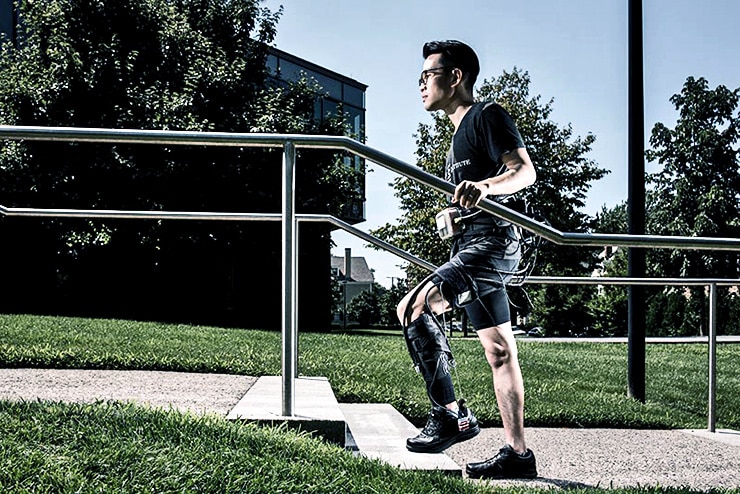Researchers have created a soft, lightweight bionic walking aid that straps to the leg and can be worn anywhere to help people recovering from a stroke walk faster, farther, and more safely.
The medical exosuit has breathable wraps made from proprietary materials, thin cables, and a series of small motors that help it mimic human muscles and tendons.
The technology has already been licensed and a suit could be commercially available for use in clinics within the next few years. That would be life changing for thousands. Researchers detail its medical benefits in the journal Science Translational Medicine.
Every year, 795,000 Americans have a stroke, which stops blood flow to parts of the brain and can leave survivors with chronic weakness or paralysis, turning walking into a frustrating—even dangerous—chore. For 15 to 35 percent of survivors, learning to walk independently can take more than six months.
Many of those who do learn to walk again will not regain their former speed or stability; according to Stroke Connection magazine, about 40 percent of all survivors have a serious fall within a year of their stroke.
More sports brace than cyborg
For a robot, the exosuit is understated, more high-tech sports brace than sci-fi cyborg; it weighs only about 10 pounds. A matchbox-sized sensor attaches to the outside collar of the shoe close to the ankle, while two black wraps cover most of the lower leg and the waist. Cables, similar to those used to control bicycle brakes, run from inside the wearer’s shoe to their calf and from the shoe’s tongue to their shin. Motors—worn around the waist and regulated by a computer unit loaded with algorithms—apply forces through the cables to help the wearer walk
“People who have had a stroke have trouble with dorsiflexion, or foot clearance,” says Terry Ellis, a physical therapy professor at the Boston University College of Health & Rehabilitation Sciences: Sargent College; they have a reduced ability to bend their ankle and lift their foot. When they try to plant their heel on the ground to walk, they instead “drag their toes and their foot gets caught.”
The exosuit counteracts that issue by retracting the cable attached to the shoe’s tongue, applying a small amount of force to bring the toes up. When the wearer needs to take a step forward, the rear cable contracts to ensure their foot pushes off the ground, a movement called plantar flexion.
From military to medical
The exosuit traces its roots to a soft robot designed for the military by a team at the Harvard Biodesign Lab at the Wyss Institute for Biologically Inspired Engineering at Harvard University. That suit is intended to help soldiers and emergency personnel carry heavy loads with minimum effort. With a similar cable, wrap, and motor combination, it works in harmony with the body to help reduce the strain associated with lugging hefty packs.

By applying assistive forces to the ankle and hip, the suit—which is still in development—reduces the amount of energy needed to carry a load equivalent to 30 percent of a wearer’s body weight by around 7 percent, according to a study published in the Journal of NeuroEngineering and Rehabilitation.
To adapt the suit to a medical purpose, Wyss invited Ellis and Lou Awad, also a physical therapy professor at Boston University, to join its team of engineers, computer scientists, and business developers. They needed “researchers who are embedded in the clinical world and work with patients,” says Ellis, director of the university’s Center for Neurorehabilitation.
The first major challenge was a practical one. The military suit was designed for “fit individuals who can handle the high amount of force” the exosuit applies to the body, says Awad.
For the suit to work, the wearer needs to be able to bear the typical forces our muscles, tendons, and bones absorb every day, as well as those the exosuit adds. That’s less of an issue for an athletic solider than it is for a senior who has suffered a stroke.
When developing the medical version, the team began by exploring less rigid textiles than those used for the military suit.
“The first prototypes used seatbelt webbing,” says Awad, director of the university’s Neuromotor Recovery Laboratory; in contrast, the medical suit is made of “composite materials that create a secure, breathable, and form-fitting interface with the wearer’s leg.”
“It’s a product of a deep understanding of how people move and how movement goes awry after something like a stroke…”
They made other changes, too. Although the original is worn on both legs versus the medical suit’s one leg, it only assists with the pushing off—the military doesn’t have to worry about soldiers dragging their toes.
“The goal with the military suit is to beat nature, break that barrier that nature provided,” says Awad. “With the medical exosuit, the goal is to bring people back to where they were.”
Both versions of the suit have sensors that tell the computer control unit—Awad calls it the brain—where a person is in their stride, so it can deliver the right amount of force for each individual.
The brain is adaptive, says Awad, “so if a person suddenly starts walking faster or changes their cadence, it recognizes that and responds accordingly.” It should eventually allow wearers to navigate uneven terrain, although testing has so far been limited to the lab.
Awad says the suit’s on-the-fly thinking is one of the features that sets it apart from others in development—and one of the team’s major contributions. Like the less rigid fabrics, the algorithms plugged into the medical exosuit’s control unit also help ensure it doesn’t put too much pressure on the wearer’s body.
“It’s a product of a deep understanding of how people move and how movement goes awry after something like a stroke,” he says. “That came from our discussions with the biomechanics team, the engineers, teaching them how people with a stroke move; they didn’t have that experience.”
Light years ahead
The medical exosuit is light years ahead of the current alternative for rehabilitation after a stroke: the ankle foot orthosis, an ungainly contraption of molded plastic that’s been in use since the early 1980s. The stiff boot runs down the calf and under the heel, holding the leg and foot at a 90-degree angle.
Awad watched as a participant began shouting, “OMG! OMG! OMG!” in happiness.
By keeping the ankle locked, the orthosis prevents the wearer from stubbing their toes and tripping, “but because you have a rigid 90-degree angle, you can’t push off, so you sort of lift the leg and lose some of the key features of a normal gait,” says Ellis. The boot allows people to gain a degree of independence, but it doesn’t get them back to the activities they love.
And, Awad adds, it may bring its own complications. “If you had a stroke at a young age,” he says, “the muscles that may not have been directly impacted by the stroke are going to suffer.”
In testing, some participants wearing the medical exosuit have been able to nearly regain their pre-stroke walking speeds. In one exosuit testing session, the user began outpacing the physical therapist monitoring his progress. In another, Awad watched as a participant began shouting, “OMG! OMG! OMG!” in happiness.
“She told me, ‘I was thinking about my grocery list; I’m never able to think about anything except walking, the next step in front of me, otherwise I’m going to fall.'”
Thought-controlled exoskeleton could let paralyzed people walk
In a series of presentations and journal articles, the researchers have quantified the suit’s impact. They found participants pushed off from the ground more effectively and used less energy, and that they walked faster over longer distances.
Ellis doesn’t intend for the suit to replace physical therapists in stroke rehabilitation. Instead, it could be used to help people relearn walking in the immediate aftermath of a stroke and allow them to practice walking at home after being discharged.
“In this country, once you’ve had a stroke, after about three months, you’re done with all the rehab,” she says. “It’s a real drawback because there are a lot of studies that show that rehab in the chronic phases is very effective and can enhance function. A therapist could prescribe the exosuit with parameters helpful for each individual.”
Moving forward
The team is pursuing funding to investigate how best to use the exosuit beyond the lab and recently won a National Institutes of Health grant to continue developing the technology. It plans to explore other applications, like customizing the suit to help people with Parkinson’s disease, multiple sclerosis, and cerebral palsy.
For now, though, the primary goal is getting the suit ready for people who have had a stroke. The medical exosuit currently only augments the ankle, but a new project with Harvard will focus on a system that integrates support for the knee and hip.
Body feedback could make assisted walking easier
The DARPA Warrior Web Project, the National Science Foundation, the Wyss Institute, the Harvard Paulson School, and the American Heart Association supported the research. Additional researchers who contributed to this work are from Harvard University and the Wyss Institute.
Source: Boston University



